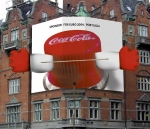Coors is realizing that sex doesn't always sell. The brewer, which has featured Diane and Elaine Klimaszewski - otherwise known as the Coors Twins, may be pulling the plug on the long running "Rock On" beer babe hottie ad campaign. It's not like we didn't see this coming with sales figures in the head-just-barely-above-water stage and beer babe backlash.
So the campaign that started with Askew (Coors CMO Ron Askew) may end up askew. The brewer has launched an agency search with new work expected to debut this fall. Current ad agency FCB isn't talking.
"I'm very pleased with our current television work but I'm always looking for new insights to better communicate with our consumers and have challenged our agencies to raise the bar for the next round of creative," said Askew.
With all this backlash, it's very likely all we'll see during next year's Super Bowl are monks and nuns (without break-away wardrobes) cautiously and conservatively convincing us the celibate life is the way to go.
The lengthy and annoying (from a consumer's perspective) commercials seen prior to a theater movie have turned into a $315.1 million business according to the latest numbers from the Cinema Advertising Council. This growth has come from realizing this captive audience as well as the proliferation of digital projectors making it very easy to manage which commercials are shown based upon location and other demographic information. If only the ads were more entertaining - or at least bearable.
Boston Red Sox Player Curt Schilling, one of the higher profile players, sells his fame to marketers just as all celebrities do. This is a perfectly acceptable direction for any popular celebrity or sports figure to take except when they are aligned with so many different brands, consumers suffer brand disillusionment and confusion. Whether they do it for the money, the notoriety or for charity, celebrity and sports figures don't know the damage they are doing to brands when they shill for multiple marketers. However, brand marketer do or should know better and should not let it happen.
Schilling has appeared in ads for Reebok, Dunkin' Donuts and New England Ford Dealers all in roughly the same time period. Is it any wonder brands are having a difficult time embedding their position in consumer's minds when they can't tell the difference between three marketers who use the same spokesperson?
To be sure, the spokesperson is just one element of a brand's position but it's a mightily visible one that has great impact on brand recall. Does Dunkin' Donuts want consumers thinking of their neighborhood car dealer or sneakers when they see Schilling in an ad? We think not.
Gothamist's Jake Dobkin writes a post questioning Jason Calcanis' Weblogs Inc. business model doubting Calcanis' ability to achieve his goal - publish 500 niche specific weblogs within the next two years. Dobkin looks at the Weblogs Inc. model from several points of view including scale, quality, finances and advertising and says things don't ad up. My take is a bit different.
While the Calcanis model is quite different than Nick Denton's Gawker Media, publisher of Gawker, Gizmodo, Defamer, Fleshbot and Wonkette, both have merit but both are portrayed very differently in the media. Nick Denton is the media darling. Calcanis is not. It's just the way it ended up. Denton gets press. Calcanis doesn't get much. It doesn't necessarily make one model better than another but it's natural to pick on the business that is "perceived" to be second tier. It's easy to snarkishly call Calcanis a Denton-wannabe when all he's trying to do is launch a business model. It's equally as easy to call Denton a fame seeker - which he most assuredly is not. Dramatizing matters further, there's the differences in voice and personality of the two publishers. When cat fights arise, Denton mostly stays quiet. Calcanis likes to debate. It's human nature to assume that one who likes to debate/fight/argue might have something to hide or something to prove rather than the majestic publisher who continually appears in the New York Times and hence, must, by nature of that appearance, be successful. Both are mis-perceptions. Both business models have a chance at success.
The Calcanis model will work just like the B to B publishing model will work. If you have trouble believing that, go to the library and look for a copy of the Business to Business SRDS - you'll find thousands of niche publications. Pick up the Consumer (Denton) SRDS and it's less than half the size. There's plenty of room for niche efforts as publishing moves to the web. There's also plenty of room for the Denton (Consumer) model. Just look at the public's salivation for all things Hilton, Spears, J-Lo, metrosexual, Wintour, Grove, etc.
Monetarily, the Gawker and Weblogs Inc. business models differ. Gawker pays a salary to its bloggers. Weblogs Inc. does a 50/50 revenue split with the blogger. Some critics of Calcanis say half of nothing is nothing. Critics of Denton say the market for snark is limited. The good thing about these two models is that there are two. We will be able to sit back and watch how each one succeeds or fails and we will, of course, comment profusely as it unfolds.
Rather than humbly address their shortcomings, a panel of newspaper executives at Thursday's ANA Print Advertising Forum in New York bristled at the thought the newspaper business is under threat. When challenge with declining circulation, Tribune Media Net President David Murphy responded, "No one likes to lose a customer. But advertising is a bundle of value. Audience size is one part of that." The number of readers may be just a part of the model but without any readers, there's no model.
Oddly supporting Murphy's statement, Mediaedge:cia Managing Partner John Miller said circulation is more important to local advertisers than national advertisers saying, "Circulation isn't a decision maker." Again, even for national advertisers, the number of readers is of some significant importance and using a statement like this as an excuse is demonstrative of desperation.
Consultant Barry Parr has written an interesting collection of posts on his MediaSavvy weblog entitle, "Why Can't A Newspaper Be More Like A Blog." Well worth the read.
Oh the pleasures of having your Mom ease your doody-induced diaper rash back in the day. Well now, thanks to Emjay Labs, makers of diaper rash cream Pinxav, you seniors can enjoy that same pleasure again although we don't think your Mom is going to apply it for you this time.
The makers of Pinxav, acknowledging the aging population and increase in diaper-wearing adults, has decided to scrounge up some marketing dollars to bring that baby-fresh feeling back to itchy seniors. Pinxav will market to nursing homes and place ads in older demo magazines and radio. Don't cry little 80 year old baby - help is on the way. Thanks to Adrants reader Charley Brough for this one.
After scouring the entire country for television stations that would accept it's "don't eat chicken ad," it found two takers in Peoria, IL. The spot, which shows images of chickens with beaks cut off and crowded into tight quarters, will air on WEEK, WMBD and WYZZ. Driving the point home, PETA Director of Vegan Campaigns Bruce Friedrich said, "If caring people give it a thought, they have to realize that animal abuse, environmental degradation, and sick consumers make the case for eating chicken corpses too tough to swallow."
They'll have to do more than advertise in Peoria to combat the lemming-like behavior of fat kids lining up at McDonald's doorway for their daily dose of Chicken McNuggets.
Sixty-seven percent of marketers surveyed by The Association of National Advertisers (ANA) indicate that newspapers and magazines could do a better job of selling itself against other media, especially television. These and other findings from the ANA survey were released today during the organization?s annual Print Advertising Forum at The Plaza hotel in New York.
The ANA survey also identified what marketers feel are the greatest threats to newspapers and magazines. The top three included: the Internet as an alternative source of information, the decline of audience and circulation numbers, and the overall clutter of advertising.
"These findings echo recently published data that indicate television advertising is not very effective for certain types of brands," said Bob Liodice, President and CEO of the ANA. "Taken together, they demonstrate there?s a clear opportunity for newspapers and magazines to deliver more effective metrics to better understand print audiences, readership and its impact on ROI."
The research also revealed that 52% of respondents believe their overall advertising budgets will increase this year. Drilling down further, 42% of respondents felt they would be increasing their magazine advertising budgets, while 22% will be decreasing spending in the area of newspaper advertising.
In addition, the ANA survey revealed that:
- 66% of marketers disagree/strongly disagree that there should be an upfront market for print advertising, but:
- 59% agree/strongly agree that early commitment of budgets should be rewarded with more favorable pricing.
- 50% of marketers agree/strongly agree that indecency is just as much a problem for print advertising as it is for broadcast
- 57% of marketers agree or strongly agree that product placement/branded entertainment is an opportunity for advertisers in print
Spoof-Boy Max is at it again. As a follow up to his "Truth" drug campaign spoof, Max has, again, enlisted his friends to, this time, portray devilish, anti-vegetarian plant murderers for a spoof ad campaign sponsored by the ficticious Society For The Protection of Plants. With the headlines, "Murderer," "Tree Killer," "Grass Murderer," "Cannibal" and "Weed Murderers," the campaign uses "graphic" photography to illustrate the horrific treatment plants get all in the name of vegetarianism.
�sk w�ppling from Adland writes about a contest Coke held to solicit scaffold billboard ideas to promote the Euro 2004 Portugal Football (Soccer to us losers in the U.S.) tournament. With the simple creative brief directive "Create a scaffolding ad that with focus on Coca Cola, will surprise and draw attention to Coke's engagement in Portugal 2004," some outstanding creative was developed. You can see the winning billboard here and the runners up here.

|







